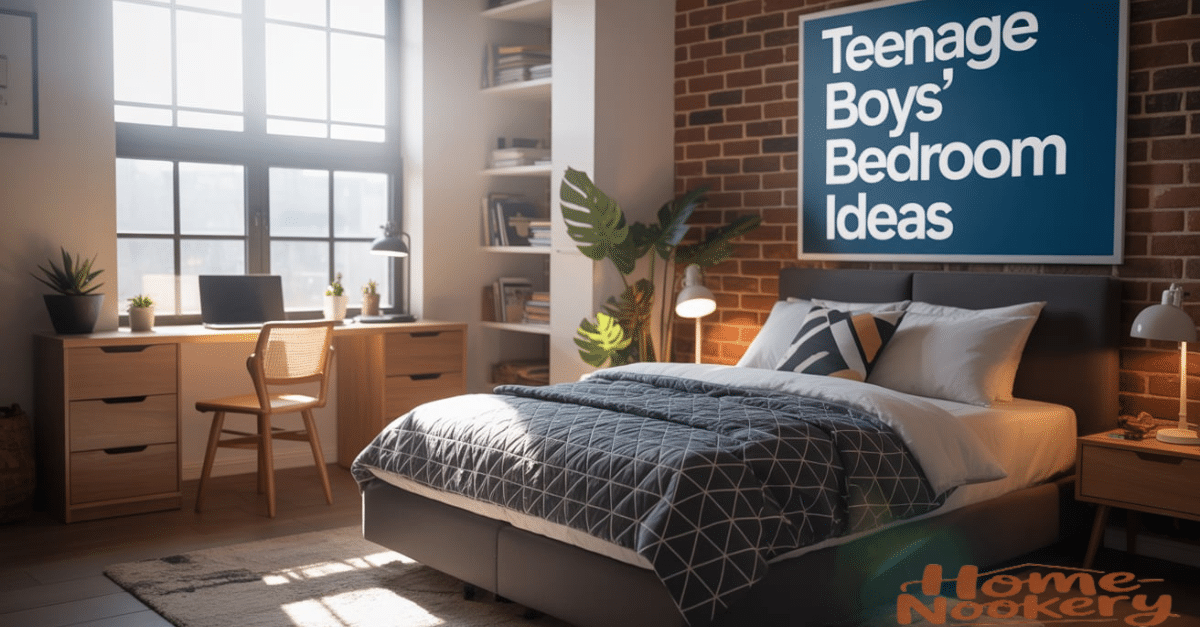Let’s face it – designing a space for teenage boys ain’t what it used to be. Gone are the days when a simple bed, desk, and poster of their favorite sports hero would suffice. Today’s teen guys are savvy, style-conscious individuals with complex needs and distinctive tastes that deserve thoughtful consideration.
As an interior design specialist who’s worked with countless families over the past decade, I’ve witnessed firsthand the evolution of teen spaces. The modern teenage boy wants a room that’s not just a place to crash, but a multifunctional sanctuary that supports everything from gaming marathons to virtual study sessions, creative pursuits, and hangouts with friends.
The best teen rooms of 2025 seamlessly blend cutting-edge technology with personal expression, creating spaces that are as functional as they are stylish. They incorporate smart solutions for organization, adaptable furniture that grows with changing needs, and personalized zones that support diverse activities. Let’s dive into fifteen innovative designs that’ll transform any teenage boy’s bedroom into the ultimate contemporary retreat.
1. Tech-Integrated Sleep Zones
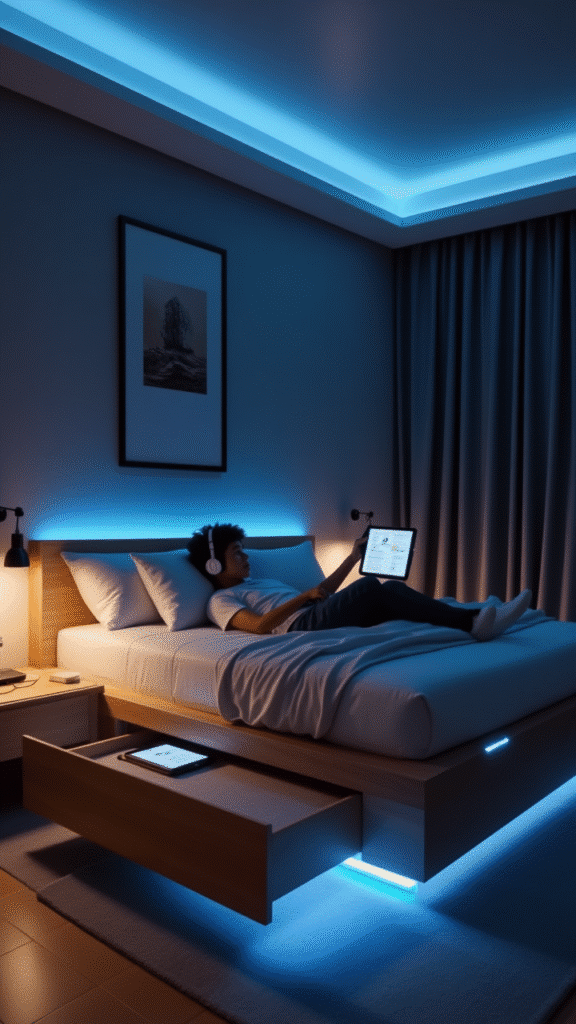
The centerpiece of any bedroom remains the sleep area, but 2025’s versions are lightyears beyond the basic bed setups of the past. Smart mattresses with temperature regulation and sleep tracking capabilities have become more affordable and mainstream. These beds automatically adjust firmness based on body position and can even gently wake teens during optimal sleep cycle points.
Ambient lighting systems integrated into headboards or ceiling fixtures simulate sunrise for natural waking or shift to calming blue tones before bedtime. Some advanced setups include subtle sound systems that deliver white noise or guided relaxations specifically designed for adolescent brains. My teenage clients are absolutely obsesed with the programmable mood lighting that syncs with their gaming systems or music preferences.
Platform beds with built-in charging stations eliminate the tangle of cables that used to clutter nightstands. These integrated power solutions often include wireless charging pads and USB-C ports concealed within the frame, maintaining the room’s clean aesthetic while keeping devices fully charged. The coolest options feature under-bed storage drawers with motion-sensor lighting that illuminates automatically when opened – no more rummaging through dark spaces for that missing controller.
2. Modular Workstations
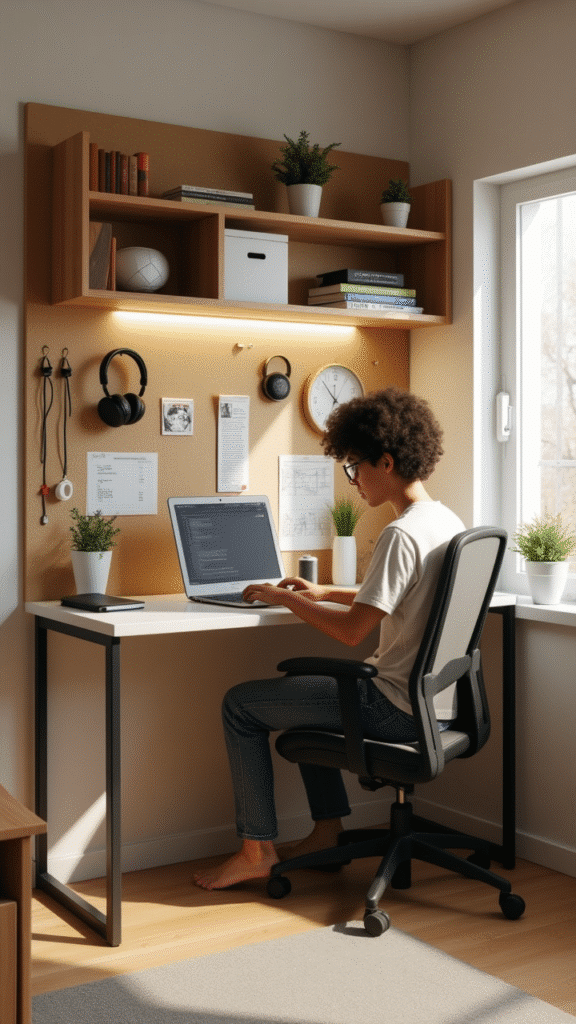
Homework spaces have evolved dramatically to support the hybrid learning environments that dominate education in 2025. Adjustable-height desks that transition from sitting to standing positions encourage healthier study habits and accommodate different types of schoolwork.
The most innovative setups feature modular components that can be reconfigured based on the task at hand. A desk that expands for group projects or contracts for focused study sessions gives tremendous flexibility. Some units incorporate built-in cable management systems and power distribution, keeping surfaces clutter-free during video lessons or digital assignments.
Display walls adjacent to study areas have replaced traditional bulletin boards, using magnetic or special adhesive surfaces that won’t damage walls. These areas allow teens to visualize projects, display achievement, or pin up inspiration without the permanence or mess of older solutions. I’ve noticed that boys especially appreciate workstations with integrated lighting that eliminates shadows when working on physical projects or reading actual books (yes, some still exist!).
3. Immersive Gaming Corners
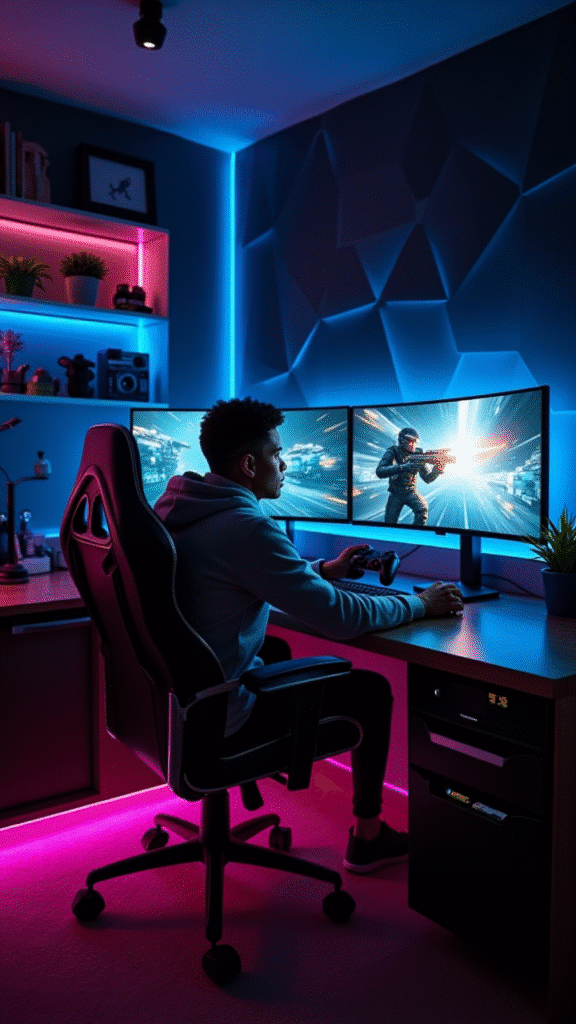
Gaming remains a central activity for many teenage boys, but the setups have grown increasingly sophisticated. Dedicated gaming zones now feature ergonomic seating with integrated haptic feedback that responds to in-game action, creating a more immersive experience without disturbing the entire household.
Acoustic panels strategically placed behind gaming stations absorb sound while adding visual interest through customizable fabrics or LED backlighting. Some families opt for partial room dividers that create semi-private gaming areas that contain both sound and light from late-night sessions. The noise-dampening solutions have literally saved family relationships in homes where bedrooms are positioned near common living spaces.
Cable management has reached new heights with systems that completely conceal the spaghetti-like tangle of wires that used to plague gaming stations. Dedicated charging docks for controllers, headsets, and peripherals keep everything organized and ready for use. The most epic setups include projector systems that can transform an entire wall into an extended gaming display for truly immersive experiences that blow traditional monitors outta the water.
4. Convertible Social Spaces
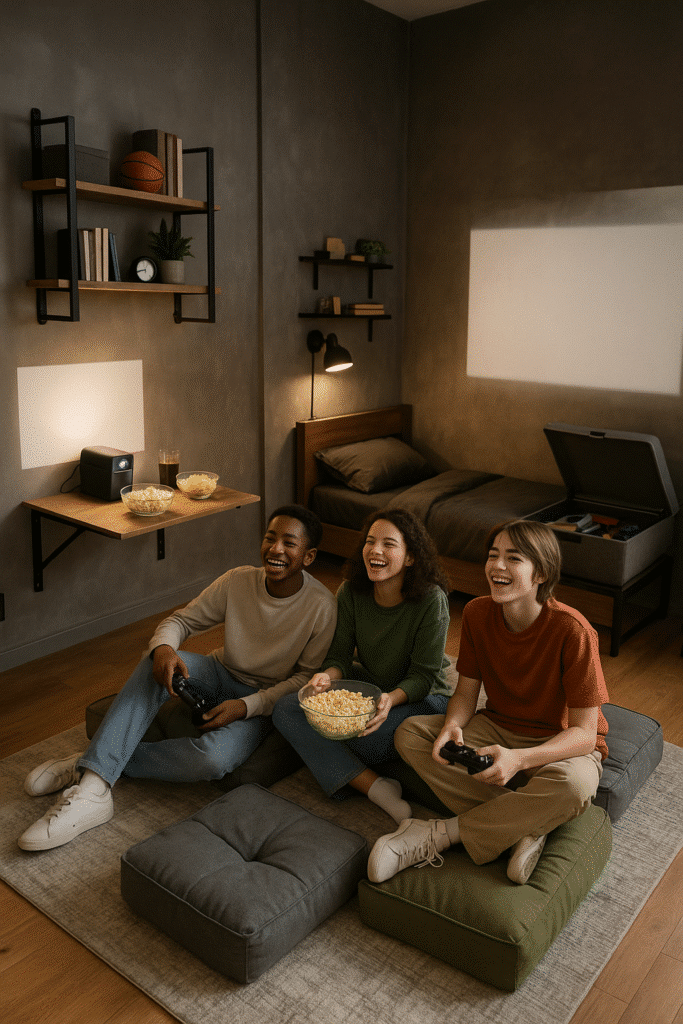
Teenage bedrooms now double as social hubs, requiring flexible seating that can accommodate friends while maintaining functionality when solo. Modular floor cushions that can be arranged into conversation pits or gaming circles have replaced the beanbags of yesteryear.
Fold-down tables attached to walls create instant snack bars or additional workspace without permanently sacrificing floor area. These surfaces can be customized with writable surfaces for impromptu game scoring or brainstorming sessions. Some of my clients have gone absolutely bonkers for ceiling-mounted projectors that transform any blank wall into a viewing screen for movie nights with friends.
The smartest designs incorporate storage within seating elements, allowing quick cleanup when parents make surprise appearances. Ottoman cubes with hinged tops conceal gaming gear, snacks, or personal items while doubling as extra seating when friends visit. These convertible spaces acknowledge the teenage need for socialization while respecting the limited square footage available in most homes.
5. Personal Expression Walls
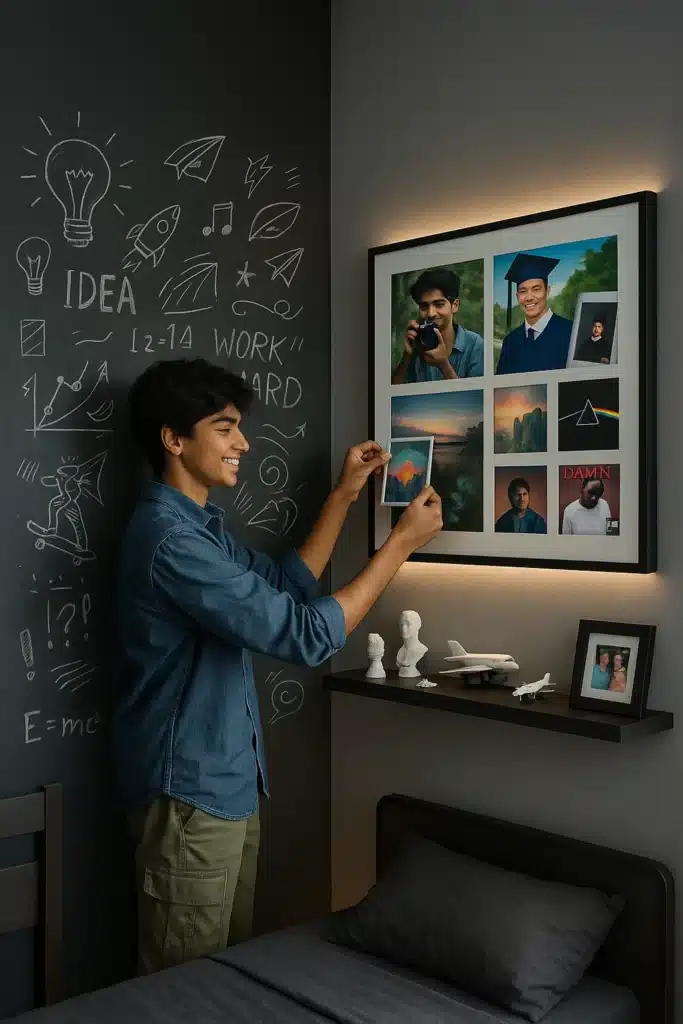
Self-expression remains crucial during the teenage years, and 2025’s bedrooms offer sophisticated solutions beyond the poster-covered walls of previous generations. Digital display panels that rotate through personal photography, artwork, or inspirational content have become more energy-efficient and affordable.
Magnetic paint sections create customizable display areas that can be constantly updated without damaging walls. These spaces allow teens to express changing interests while maintaining a cohesive overall design. The magnetic surfaces are brilliant for displaying everything from concert tickets to small metal sculptures or modular lighting elements.
For the artistically inclined, dedicated creation walls featuring special markers, paints, or projection systems allow for constantly evolving expression. Some advanced systems can digitally capture physical artwork created on these surfaces, allowing teens to preserve their work digitally while making room for new creations. I’ve seen teenage boys create absolutly mind-blowing murals using these systems, challenging stereotypes about who enjoys visual arts.
6. Smart Storage Solutions
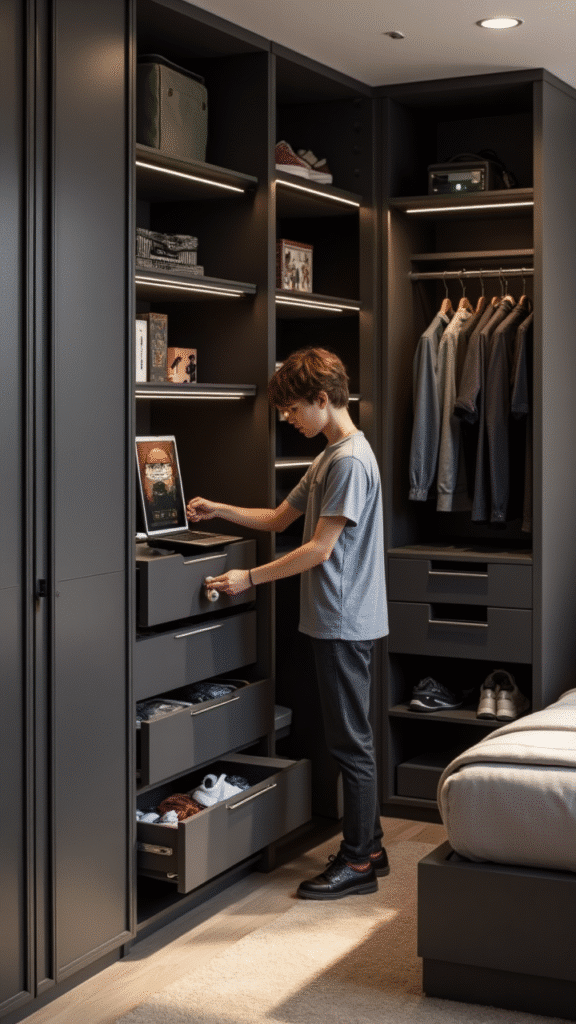
Organization remains the eternal challenge in teenage bedrooms, but 2025’s solutions make maintaining order considerably more achievable. Vertical storage systems maximize wall space with adjustable components that can be reconfigured as needs change throughout the teenage years.
Under-bed storage has evolved from simple drawers to sophisticated systems with categorized compartments, some featuring vacuum-compression technology for seasonal clothing or bedding. These systems often include biometric locks for items requiring privacy or security, respecting teens’ growing need for personal boundaries. The coolest ones I’ve installed have motion-activated lighting that makes finding stuff under the bed so much easier than the flashlight-in-mouth approach we all grew up with.
Closet systems now commonly include algorithm-assisted organization apps that track clothing items, suggest outfits, and even notify when laundry should be done based on usage patterns. Some advanced systems include built-in refreshing cabinets that use steam and ultraviolet light to reduce the need for frequent washing, appealing to both environmentally-conscious teens and parents tired of overflowing hampers.
7. Biophilic Design Elements
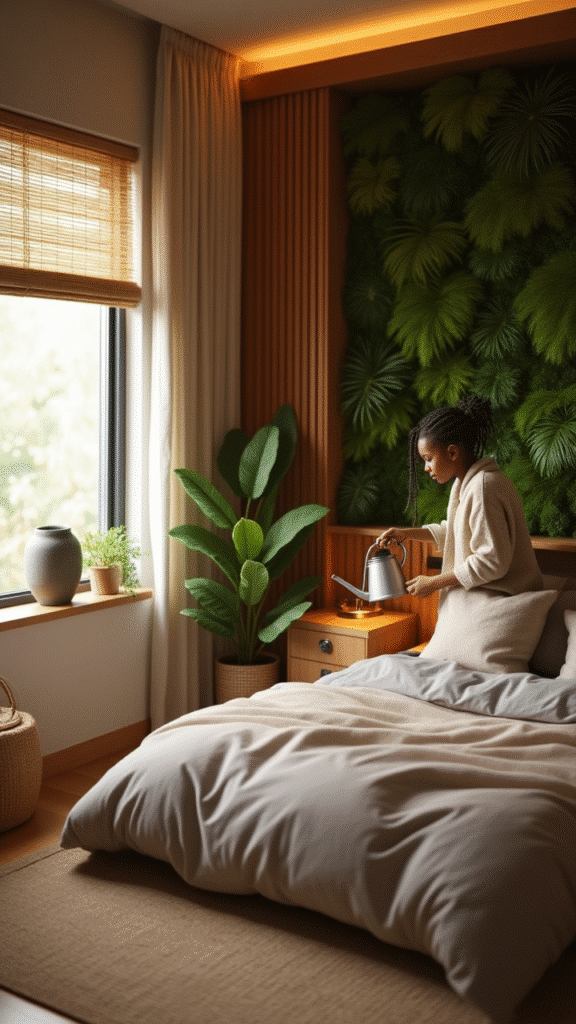
Connection with nature has become increasingly important as screen time dominates teenage life. Modern bedroom designs incorporate living walls with low-maintenance plants that improve air quality while adding visual warmth to tech-heavy spaces.
Circadian lighting systems that mimic natural daylight patterns help regulate teen sleep cycles often disrupted by hormonal changes and screen exposure. These systems automatically shift from energizing morning light to warmer evening tones, supporting healthy sleep patterns. Some families have gone as far as installing small water features that provide gentle ambient sound and humidity control – creating multi-sensory connections to natural environments.
Window treatments have evolved beyond basic light blocking to include programmable opacity levels that adjust throughout the day, maximizing natural light while maintaining privacy. The smartest systems link with alarm settings, gradually increasing light levels to wake teens more naturally in the morning. My teenage clients are genuinely shocked at how much better they feel when their lighting syncs with natural patterns instead of harsh overhead fixtures.
8. Acoustic Management
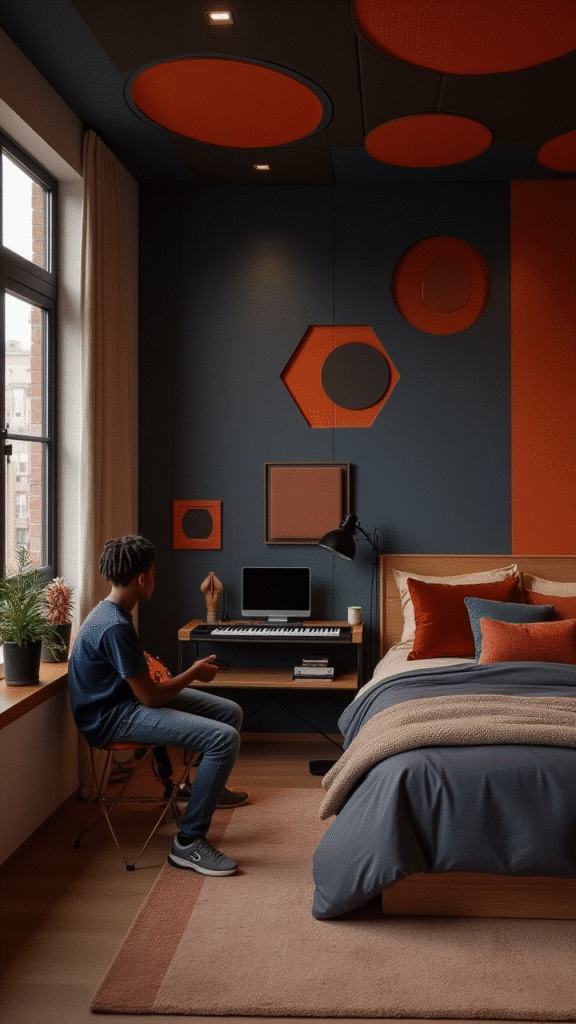
Teenage boys can be loud – whether they’re gaming, playing instruments, or just hanging with friends. Modern bedrooms incorporate strategic acoustic management without resembling recording studios. Decorative sound-absorbing panels that double as artwork create visually interesting focal points while dampening noise.
Ceiling treatments with sound-absorbing properties help control reverberation without sacrificing style. These often incorporate lighting elements or projections that add visual interest while performing acoustic functions. Some families have opted for partial sound isolation where one zone of the bedroom receives more intensive acoustic treatment for music practice or gaming sessions.
Flooring solutions have evolved to include sound-dampening underlayments beneath stylish finished surfaces, reducing sound transmission to rooms below. Area rugs with specialized backing materials add comfort underfoot while providing additional acoustic benefits. The difference these treatments make isn’t just about volume – the quality of sound within the space improves dramatically, making everything from music to conversation more enjoyable.
9. Personalized Climate Control
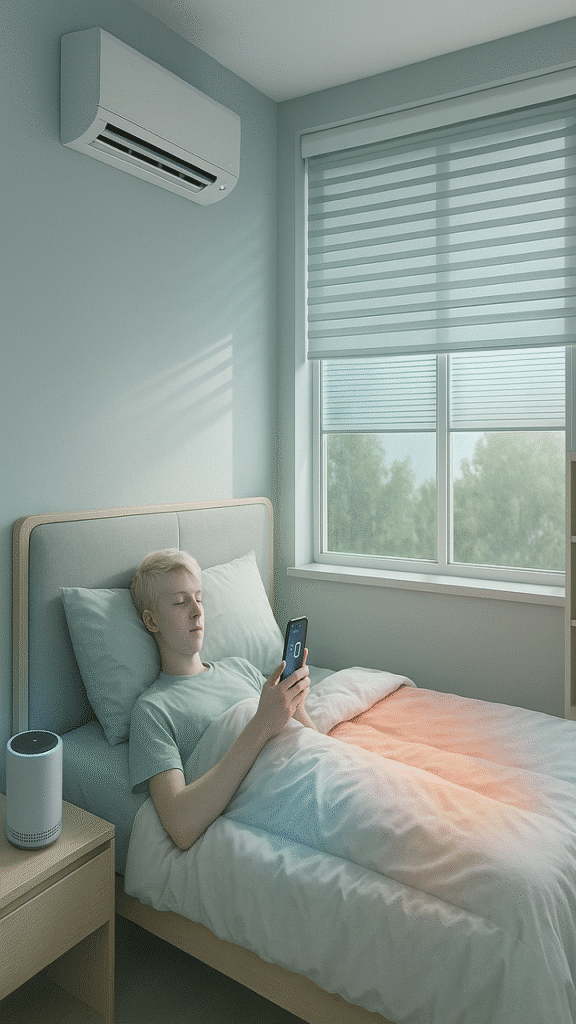
Individual climate preferences can be addressed through zoned environmental controls rather than battling over household thermostat settings. Personal fans with air purification capabilities create microclimate zones within the bedroom, allowing for customized comfort.
Window treatments with thermal properties help regulate temperature while reducing energy costs. Some advanced systems include sensors that automatically adjust based on sunlight intensity and room occupancy. My clients in particularly sunny locations are obsessed with the new electrochromic glass that tints automatically based on sunlight intensity, eliminating the need for separate window coverings entirely.
Bedding systems have evolved to include temperature-regulating materials that adjust to body heat, solving the perpetual too-hot-too-cold dilemma that plagues teenage sleep. Some incorporate subtle heating elements for winter months or cooling technology for warmer seasons, all controllable through smartphone apps. These personalized climate solutions not only improve comfort but can dramatically reduce household energy consumption by targeting climate control exactly where its needed.
10. Adaptable Lighting Ecosystems
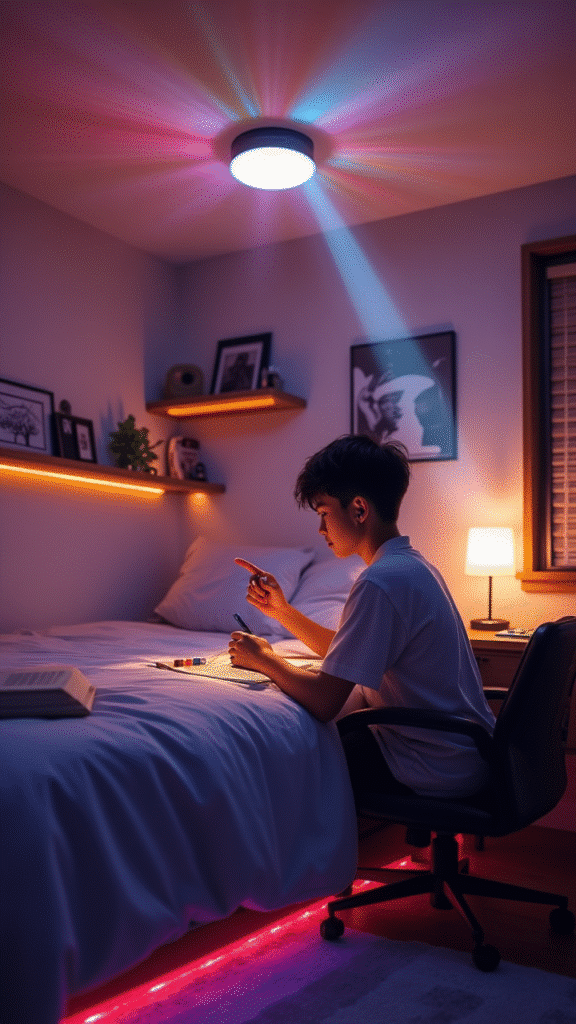
Lighting design has transcended the basic overhead-plus-desk-lamp configuration of previous decades. Modern teen bedrooms feature layered lighting ecosystems with ambient, task, and accent lighting that can be configured for different activities and moods.
Task lighting with adjustable color temperature helps reduce eye strain during homework sessions, while ambient options create atmosphere for relaxation or socializing. Some systems include tracking mechanisms that direct focused light exactly where needed without illuminating the entire space. The beam-forming technology that follows movement around the room feels like something straight outta sci-fi movies but has become suprisingly affordable.
LED strip lighting has evolved from the basic color-changing varieties to systems that respond to music, gaming activity, or even biometric indicators of stress. These can be integrated into furniture edges, ceiling coves, or under beds to create immersive environments without overwhelming the space. Many teens program lighting scenes that support different activities – transitioning automatically from homework mode to gaming setups with a simple voice command.
11. Multi-Sensory Relaxation Zones
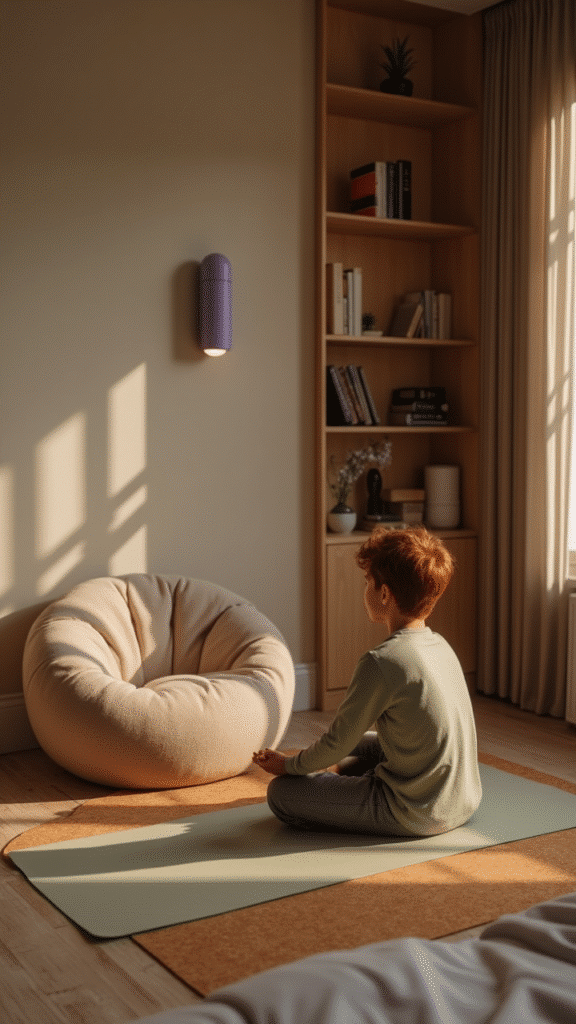
Mental health awareness has influenced bedroom design significantly, with dedicated areas for decompression becoming standard features. Comfortable reading nooks with specialized lighting and acoustic properties provide spaces for mindful disconnection from digital stimulation.
Meditation corners equipped with subtle guidance technology help teens develop valuable self-regulation skills during these emotionally turbulent years. Some incorporate gentle haptic feedback in seating elements that guide breathing patterns or provide grounding sensations during anxiety spikes. The impact of these intentional relaxation zones extends beyond the bedroom – teachers have reported improved focus and emotional regulation at school when teens have access to these spaces at home.
Scent diffusion systems with scientifically-supported aromatherapy options help create calming environments or energizing atmospheres depending on needs. These systems can be programmed to activate at specific times or in response to voice commands, supporting everything from morning routines to pre-sleep relaxation. Many of my clients have been amazed at how effectively these multi-sensory approaches help address the stress and anxiety that’s so prevalent in teenage life.
12. Creative Expression Stations
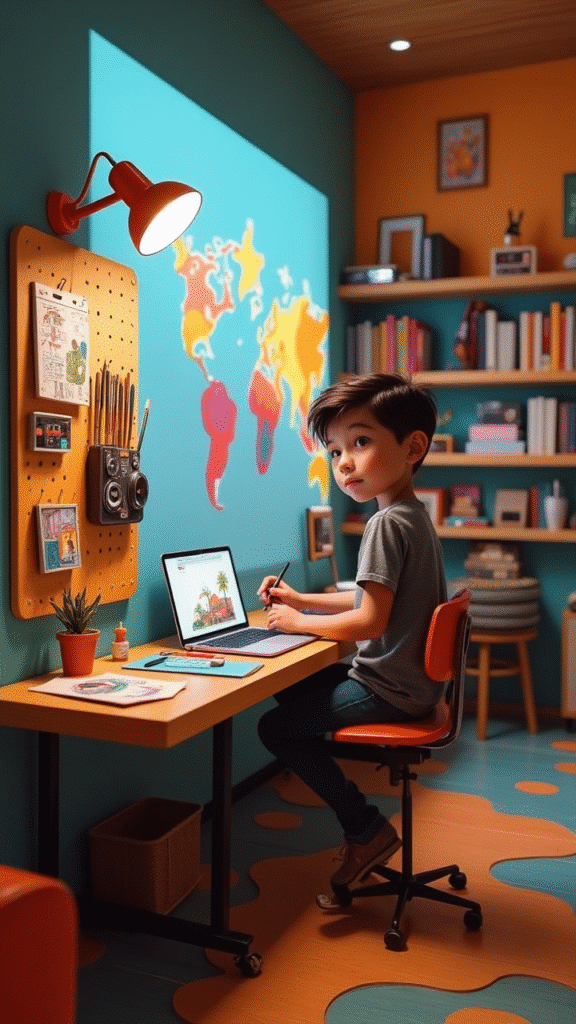
Artistic and creative pursuits need dedicated space beyond the traditional desk setup. Modern teen bedrooms often include specialized zones for music production, visual arts, or other creative hobbies with appropriate surfaces and storage for materials.
Digital creation stations with pen displays or augmented reality interfaces support both traditional and digital artistic expression without requiring separate devices. These systems often include project management software that helps teens organize creative endeavors alongside academic responsibilities. The boundary between digital and physical creation continues to blur, with some of the most interesting teen work happening precisely at this intersection.
For musically inclined teens, instrument storage solutions that double as display elements keep guitars, keyboards, or other instruments accessible while protecting them from damage. Some include integrated recording capabilities that capture spontaneous creative moments without requiring elaborate setup. The emphasis on creative expression reflects growing recognition of its importance in cognitive development and emotional wellbeing during the teenage years.
13. Sustainable Design Elements
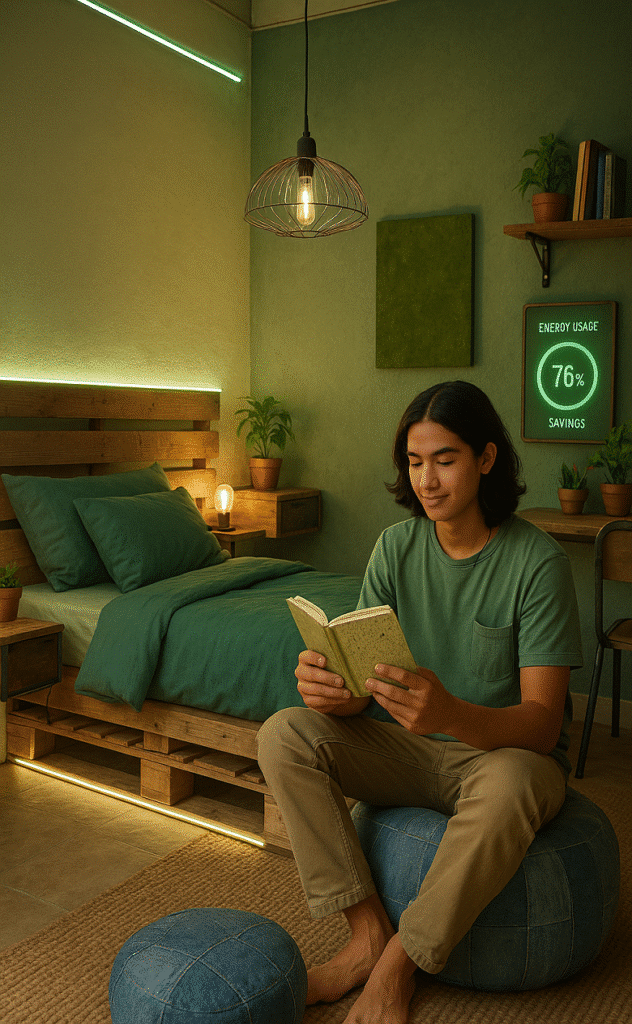
Environmental consciousness influences modern teen bedroom design significantly, with sustainable materials and energy-efficient systems becoming expected rather than exceptional. Furniture crafted from reclaimed or certified sustainable materials brings environmental values into everyday spaces.
Energy monitoring displays that gamify conservation efforts help teens understand their environmental impact while developing responsible habits. Some systems include reward mechanisms that translate energy savings into tangible benefits like extended screen time or credits for digital content. These practical applications of environmental values have proven much more effective than abstract lectures about responsibility.
Upcycled elements that transform vintage or otherwise discarded items into functional components add character while reducing consumption. Old industrial elements repurposed as lighting fixtures or storage solutions create visual interest with minimal environmental impact. Many teens actively participate in sourcing these elements, turning sustainability into an expression of personal style rather than a compromise or sacrifice.
14. Physical Activity Integration
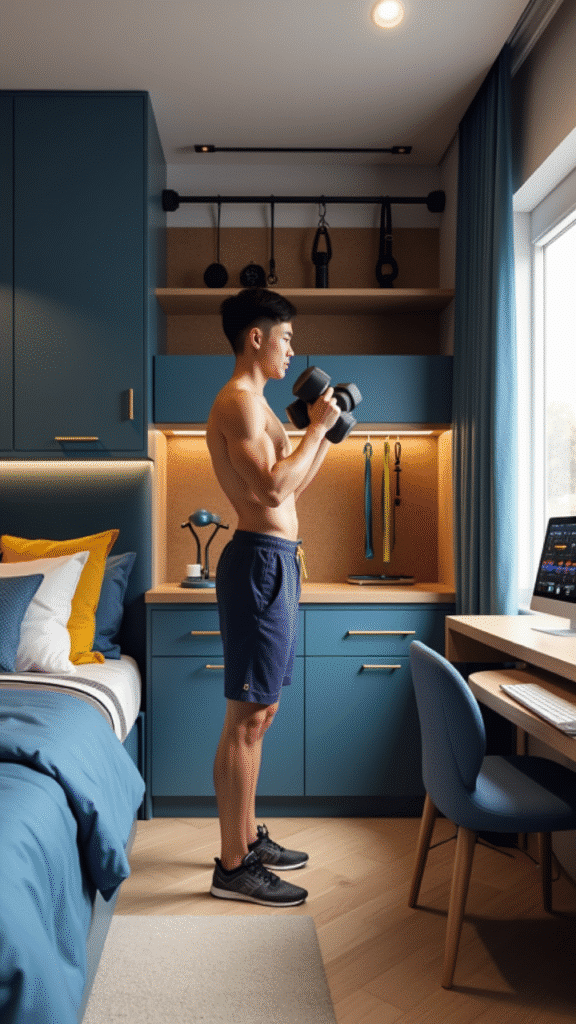
Combating sedentary lifestyles has become a design priority in teen spaces, with elements that encourage movement throughout the day. Compact exercise equipment designed specifically for bedroom spaces allows for quick activity breaks without requiring dedicated workout rooms.
Standing desks with balance boards or subtle movement elements encourage physical activity during otherwise stationary tasks like homework or gaming. Some include gamified elements that track movement and reward regular position changes throughout study sessions. These small interventions can significantly impact physical health without feeling like forced exercise regimens that teens typically resist.
Ceiling-mounted suspension points for resistance bands, yoga hammocks, or other equipment provide flexible workout options without permanent floor space commitment. These can be easily concealed when not in use, maintaining the room’s aesthetic while supporting physical wellbeing. My clients are often shocked at how much more physical activity happens naturally when the equipment is integrated directly into spaces where teens already spend their time.
15. Cultural Identity Expression
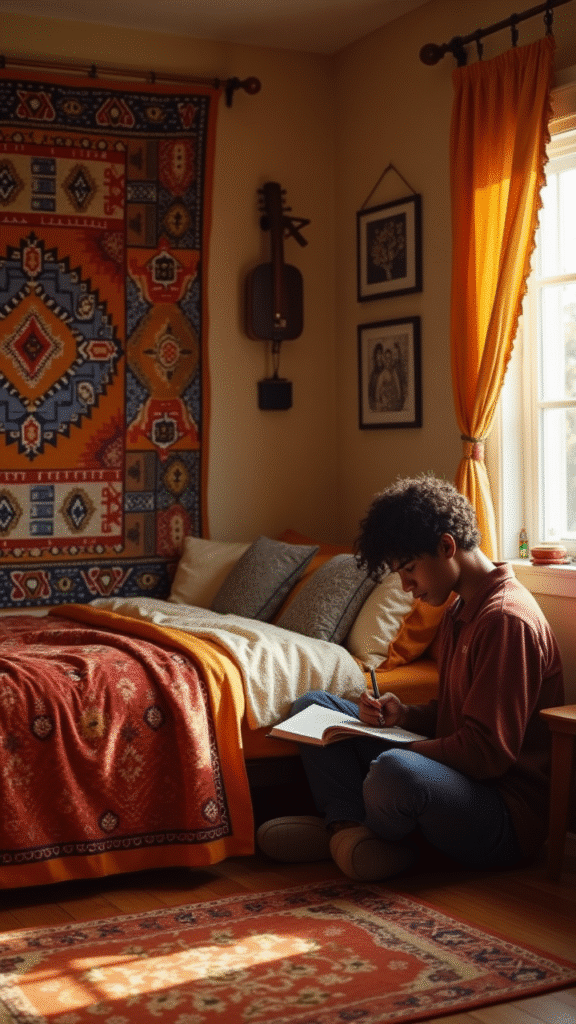
In 2025, teenage boys are finding meaningful ways to reflect their cultural heritage through thoughtful, modern design—without falling into stereotypes. Instead of generic motifs, today’s bedrooms use authentic elements that feel personal and integrated. Digital frames rotate images of family history, traditions, or even poetry in heritage languages, offering quiet yet powerful affirmations of identity.
Soundscapes featuring traditional instruments or ambient audio from ancestral regions can be woven into smart home systems, creating a subtle connection to roots during everyday routines. Textiles are another vehicle—custom bedding, rugs, or wall hangings inspired by indigenous patterns or heirloom techniques add depth and storytelling to the space. These details work best when naturally incorporated, allowing the room to reflect who the teen is, not just where they’re from. In a world increasingly globalized, such grounded touches help young people stay connected to where they belong.
Final Thoughts
Teenage boys’ bedrooms in 2025 are more than just four walls and a bed—they’re personalized environments where style, function, and emotional well-being intersect. From immersive gaming zones to spaces for mindfulness and cultural expression, today’s designs reflect a growing understanding that teens need flexibility, identity, and autonomy in their private spaces.
The most successful designs don’t just look good—they grow with the teen, support their evolving routines, and help them navigate one of life’s most transformative stages. Whether you’re a parent, designer, or teen yourself, remember: this space isn’t just a bedroom—it’s a foundation for independence, creativity, and self-discovery. Invest in it wisely, and it will return more than just aesthetic value—it’ll support a healthier, more confident young adult.

Mariana is the founder and voice behind Home Nookery, a curated blog dedicated to home design, décor inspiration, and cozy living. With a passion for creating beautiful, functional spaces, Mariana shares practical tips, styling ideas, and thoughtful insights to help readers turn their houses into homes. Whether you’re redesigning a room or just adding a touch of charm, she’s here to guide you with creativity and heart.
